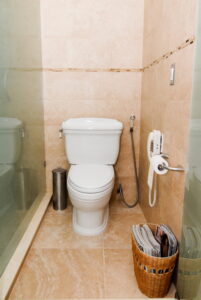 We know that an overflowing toilet is one of those plumbing problems that can cause a sudden burst of panic when it strikes. You might immediately have images of large parts of your house flooding as you desperately try to get somebody to fix the problem.
We know that an overflowing toilet is one of those plumbing problems that can cause a sudden burst of panic when it strikes. You might immediately have images of large parts of your house flooding as you desperately try to get somebody to fix the problem.
We have good news. First, you have somebody on your side who can fix the problem—you’re already on our website and we’re only a phone call away for the toilet repair in Snellville, GA that will take care of your malfunctioning throne. Second, with the proper steps, you can quickly stop serious trouble from the overflowing toilet and have your immediate fears calmed down so you can wait for our arrival in relative peace. For additional tips, see our guide on how to prepare for an emergency plumbing situation.
We’ll go through the basic steps of what to do when you’ve got an overflowing toilet.
Step 1: Stop the flow of water
You don’t want water to continue to spill out of the toilet onto the floor, so turn off the flow of water at the feed tube. This is the plastic tube that connects the tank of the toilet to the home’s water system, and it connects to the wall behind the toilet. Turn the valve on the tube, and the water will stop flowing.
Step 1 Alternate: “I don’t see a valve!”
An older toilet may not have a valve. In this case, what you’ll need to do is take off the lid of the tank and pull up on the chain to the flapper until it stops the water flow. You’ll need to brace it up to keep it in place. Thankfully, there are very few toilets left that don’t have a valve on the feed tube.
Step 2: Absorb the spilled water
Large water spills on a bathroom floor pose a danger of the water seeping down into the floor material, where it can lead to mold, mildew, and wood rot that weakens the floor. The spillage can also spread harmful bacteria around. Mop up as much water as you can using old towels to absorb the water. If you own a wet-dry vac, now is the time to put it to use. Get as much water removed as you can. For more advice on handling flooding, check out our article on flooding and emergency plumbing concerns.
Step 3: Attempt to plunge the toilet
Now you can see if the problem with the toilet overrunning was a clog. Take a toilet plunger (different from a sink plunger because of the flanges on the end) and see if you can push out the possible clog. If the water flows out of the toilet after you’ve tried this, you may turn back on the feed valve and try to flush the toilet again to see if the problem is solved—but be prepared to turn off the feed valve again if it looks like the toilet is about to overflow a second time.
Step 4: Call a plumber
If a plunger didn’t solve the issue, then you’ll need to rely on professional plumbers. Give our team a call. We can’t be there instantly, of course, but we’re responsive and will get to you fast to find out what’s wrong and then have it fixed. For insights on when to call for professional help, see why professional plumbing is a must.
Call on Snellville Heating, Air and Plumbing when you need fast plumbing repairs. “Your Comfort Is OUR Business.”




